When most people think of getting an ultrasound, the first thing that comes to mind is finding out the baby’s sex. But there’s much more to it. Sonograms are used to determine the gestational age of a pregnancy. Naturally, one of the most frequently asked questions is: how accurate is conception date based on ultrasound
The most precise way to date a pregnancy is with an ultrasound done between 6 – 8 weeks. Even though ultrasound scans show what is happening inside your body in real-time, making them the best method for determining the conception date, they are not 100% accurate.
In this post, we’ll go over the process of conception and gauge its efficacy in helping you figure when you conceived.
What is the Conception Date?
The idea of immaculate conception has been largely discredited by science. An obvious fact is you cannot conceive until you ovulate. Ovulation is one of the prerequisites for the procedure to take place. Ovulation occurs approximately 14 days before your period begins. You ovulate around day 14 of a 28-day menstrual cycle, and your most fertile days are days 12, 13, and 14. Ovulation occurs on day 21 of a 35-day menstrual cycle, and the most fertile days are days 19, 20, and 21.

If an egg comes into contact with a viable sperm during the fertile days, fertilization occurs. This is the date of conception. It has numerous applications in prenatal care, including:
- Enables accurate dating of your pregnancy
- Appropriate intervals for prenatal care visits
- The proper timing of specific interventions. For instance, the screening test for open neural tube defects like spina bifida or anencephaly must be conducted at a particular time.
- Reduces the occurrence of post-term pregnancies or preterm labor.
How Do Ultrasounds Work?
If you are wondering how accurate is conception date based on ultrasound, you must first understand how it works. A small probe, known as a transducer, is used to transmit sound waves into the body and record the waves that echo back. The recorded echoes are converted into 2D or 3D video or picture photos of your kid. The echo, or bouncing back, gives the ultrasound image its characteristics.
During pregnancy, two types of ultrasound are given: transvaginal and transabdominal.
Transvaginal Ultrasound
It is usually done very early in pregnancy – usually before week 7. During this procedure, a wand-shaped transducer is inserted into the vaginal canal. Transvaginal ultrasounds are used where abdominal ultrasounds aren’t providing enough information and may be used later in your pregnancy. However, when transvaginal ultrasounds are given during early pregnancy, it aims to:
- Confirm your pregnancy
- Monitor your baby’s heart rate and position
- Look for indicators of ectopic pregnancy
- Determine how many fetuses are present in the uterus
Although the procedure is painless, you may find it uncomfortable, similar to a pelvic exam.
Transabdominal Ultrasound
Most pregnant women have a transabdominal ultrasound around the 18th to 22nd week of pregnancy. Some gel is smeared on your belly, and a transducer is then pressed against the exposed abdomen to give feedback. When the cold gel comes into contact with your skin, you may feel a chill – but it will soon subside. As the doctor moves the transducer along your abdomen, applying some gentle pressure, the transducer transmits sound waves that create a picture of the baby on the screen.
They capture pictures of the baby’s organs and measure various features of the fetus as it develops. Analyzing these details can help you figure out when you were conceived.
So, How Accurate is Conception Date Based on Ultrasound
Obstetricians recommend every pregnant woman have at least two ultrasound examinations – one during the first semester and another in the second semester. However, although ultrasounds are the best tool for dating pregnancies, they are not 100% accurate. The reliability of an ultrasound test can vary depending on several factors, including:
- The stage of the pregnancy
- The machine’s quality
- The skill of the technician
- The baby’s position in your womb
A study conducted in Australia between 2007 and 2011 found that only 5% of the assessed cases gave birth on the exact predicted date. The majority delivered a week before or after the EDD.

Unfortunately, there isn’t a way to know exactly when you conceived with certainty. But, when put up against other methods of predicting conception date, results derived from ultrasounds are more trustworthy. It’s more accurate than date-based calculation, especially for women with irregular periods or who don’t know their last menstrual period.
The margin of error for conception dates estimated with early ultrasonography is about 1 – 2 weeks. If the ultrasound due date is within this margin of error, doctors will usually preserve the original due date (the one calculated from the last menstrual period).
What About LMP to Determine Conception Date?
Some people use LMP to establish the conception date. This is because most women ovulate two weeks after their period ends, and ovulation is when you are most fertile and most likely to become pregnant. This method involves counting forward two weeks from the beginning of your last menstrual cycle.
However, due to various factors, LMP may indicate an incorrect conception date by day that can be off by up to two weeks.
- Although the average woman ovulates (releases an egg) about two weeks following her period, the precise time of ovulation is not always known.
- If you used to have irregular periods, it’s easy to get the specific LMP date wrong.
Getting an ultrasound is painless and safe. Ultrasound exams produce images and measurements of your developing baby that can help you figure out how far along you are and your approximate conception date.

I’m Cathrine and I’m a 39-year-old mother of 3 from Utica, New York. And I’m extremely happy you’ve come to visit my hide-out on the web. Here I post about everything related to family-life and usually it will involve babies and lessons I’ve learned over the years from experts, friends, and my own mistakes. So hopefully you will find what i write fun and informational!


